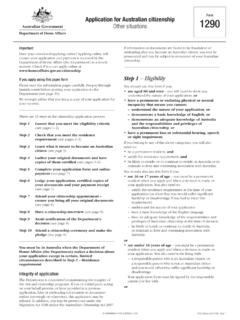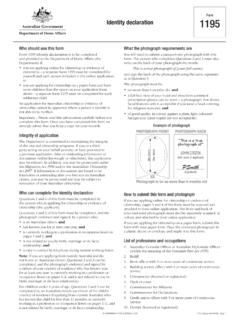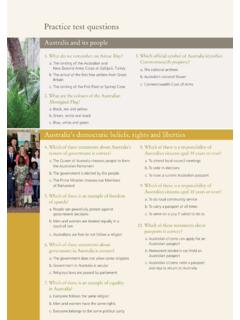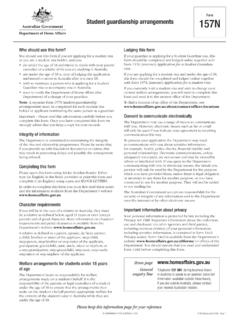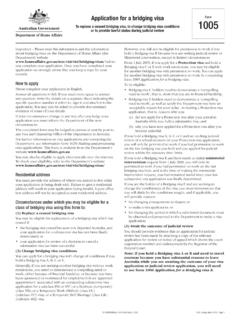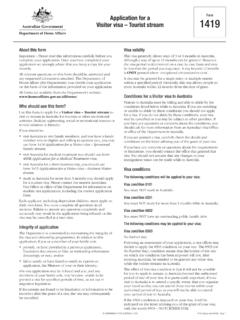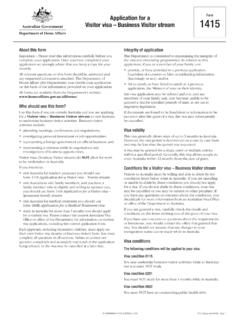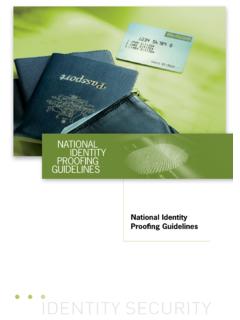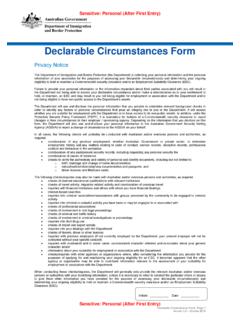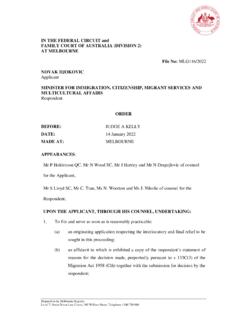Transcription of A History of the Department of Immigration - Managing ...
1 A History OF THEDEPARTMENT OF IMMIGRATIONM anaging Migration to Australia i A History OF THEDEPARTMENT OF IMMIGRATIONM anaging Migration to AustraliaFirst published June 2015 Revised edition June 2017 Commonwealth of Australia 2017 Unless otherwise noted, copyright in the content of this publication is owned by the Commonwealth of Australia, represented by the Department of Immigration and border Protection (DIBP). On and from 1 July 2015, the australian Customs and border Protection Service (ACBPS) is merging with DIBP to create the new Department of Immigration and border Protection. This will include the australian border Force (ABF).All material presented in this publication is provided under a Creative Commons Attribution Australia licence, with the exception of: the Commonwealth Coat of Arms ACBPS and ABF logos, emblems and trademarks content supplied by any third parties (as identified).The details of the relevant licence conditions are available on the Creative Commons website: a third party holds copyright in material in this publication, the copyright remains with that party.
2 Their permission may be required to use this material. Use of the Coat of ArmsThe terms under which the Coat of Arms can be used are detailed on the It s an Honour website: usEnquiries regarding the licence and any use of this document are welcome at:Communication and Media Branch Department of Immigration and border Protection PO Box 25 BELCONNEN ACT 2616 Telephone: (02) 6264 2233 Email: image: A group of displaced persons on the train to Bonegilla, Victoria, 1949. Image courtesy of the National Archives of Australia, A8139, volume 7. iii A History of the Department of Immigration Managing Migration to Australia has been written to commemorate the 70th anniversary of the establishment of the Department of Immigration in July 1945. It is intended to be a brief History that captures the key events, and has relied on extensive research to ensure that the information included is as accurate as possible. Any opinions, comments and analyses expressed in this publication are those of the authors and do not necessarily represent the views of the Mence, Simone Gangell and Ryan Tebb from the Irregular Migration and border Research Section, Weerasinha from the Production and Design, Communication and Media Branch, authors are grateful for the assistance and advice provided by Alex Parrinder and Christopher Ritchie, DIBP, in preparing this publication.
3 We would like to thank senior executive officers and other colleagues in the Department for their valuable comments on earlier drafts. We would especially like to acknowledge the time given by long-serving officers who provided fascinating personal stories and reflections on some key events in the Department s History . ContentsIntroduction vihapter One: Migration to Australia 1 efore FederationThe first Australians 2 Early exploration of the continent by Europeans 3 Britain claims Australia and begins a bold experiment 4 Colony expansion and the gold rush 5 Non-British arrivals 6 Immigration policies in the lead-up to Federation 7hapter Two: Federation to the end 9 f World War II One people, one destiny 10 Early Immigration and the White Australia Policy 12 The dictation test 14 Immigration patterns following Federation 16 World War I 17 Post-war Immigration boom in the 1920s 18 Refugee rescue 20 World War II 21 CbCoiv A History of the Department of Immigration Managing Migration to AustraliaChapter Three.
4 Populate or perish 25 The Displaced Persons Scheme 28 Assistance to settle in Australia 31 Immigration and nation building 33 Assisted Immigration schemes in the 1950s and 1960s 35 Ten Pound Poms 36 Nationality and citizenship 40 The Department drives a new approach to Immigration 43 Non-European Immigration 44A new secretary and policy reform 45 Humanitarian resettlement 46 Chapter Four: Migration and multiculturalism 49 Transition to multiculturalism 51 The Department s functions expand 52 Assimilation, integration, multiculturalism 53 Settlement services 54 Reduced Immigration 56A new approach to attracting migrants 57 Resettlement of those in humanitarian need 59 Establishment of the Humanitarian Programme 60 Australia becomes a popular destination 65 Chapter Five.
5 Managing migration 67 in a dynamic and complex worldManaging short-term visitors and encouraging migration 70 Shifting the emphasis to business and skills 71 Strengthening the border 72 The second wave of unauthorised migration by sea and by air 73 Operation Safe Haven 74 The Pacific Strategy 76 The Department s work with the international community 77 Special events 78 International travel temporarily declines 80A shift in the Department s culture 81 Working holiday schemes 82 The third wave of unauthorised migration 83 The Department of Immigration and border Protection 84 Snapshot of departmental business 85 Conclusion 86 Appendix 87 Former and current ministers 88 Former and current departmental secretaries 90 History of departmental names 92 Notes 93 References 99 Timeline photo captions 106 Right: A family leaves the australian Migration Office in Birmingham after an interview, 1962.
6 Image courtesy of the National Archives of Australia, A12111, 1/1962/14/31. v IntroductionThis publication is a brief History of the Department of Immigration (the Department ) and captures some of the key events, highlights and challenges relating to Immigration to Australia. It has been prepared in commemoration of the 70th anniversary of the Department s establishment in July 1945. It also marks the formal amalgamation of the australian government s Immigration and customs portfolios and the establishment of the australian border Force that will officially take place on 1 July 2015. Chapters one and two look back at the early History of Immigration to Australia. This early History provides a useful context for understanding the challenges faced by the new Department in overseeing an ambitious nation-building plan in the post-World War II period. These chapters reflect upon the historical policies which maintained a restricted approach to Immigration that primarily favoured migration from Britain.
7 Throughout the first half of the 20th century non-British migrants were not encouraged, and non-Europeans were excluded altogether, although some European groups did manage to filter through. The Immigration History of Australia prior to the establishment of the Department provides an indispensable backstory to appreciate the magnitude of the transformation of australian society that the Department presided over in implementing the Immigration programme following the end of World War II. Chapter three examines the establishment of the Department in 1945 and the first two decades of the Immigration programme. By necessity, the new Department had to look beyond the British Isles to achieve the scale of Immigration the Curtin and Chifley Governments championed with bipartisan support. The first two substantive secretaries of the Department , Tasman Heyes and Peter Heydon, both engineered and guided the establishment of the Migration Programme. Heyes oversaw the diversification of the programme to include people from across Europe, beginning a process that transformed the social and cultural landscape of Australia.
8 When Heydon became the Secretary of the Department in 1961, he began a process of dismantling the White Australia Policy approach to Immigration , which had defined Australia s approach to Immigration since before Federation. Heydon prepared the way for a non-discriminatory programme that considered applicants on the basis of merit and skills rather than the colour of their skin. Chapter four covers the 1970s and 1980s, exploring how the Department managed the advent of jet travel and the decline of the migrant ships that had been such a feature of the migration journey to Australia. During this period, the Department shifted the Migration Programme away from the assisted migration schemes, which had characterised Immigration to Australia since settlement, to a programme that started to respond more specifically to Australia s economic, social and labour concerns through a greater focus on skills and family reunion. The Department further refined its migrant settlement services, creating a model that was admired and emulated by other countries.
9 The chapter also traces the tradition and practice of humanitarian resettlement which began with the resettlement of 170,000 people from displaced persons camps in Europe and continued throughout the 1960s with discrete groups of refugees resettled from Europe, South America and the Middle East. This was followed by refugee boat arrivals from Indochina after the end of the Vietnam War and the Khmer Rouge takeover of Cambodia in 1975. In response to the unprecedented phenomenon of asylum seekers arriving on Australia s doorstep, the Humanitarian Programme was established in the late 1970s to provide a more targeted and orderly response to future refugee A History of the Department of Immigration Managing Migration to Australia vii The final chapter surveys the rapidly expanding responsibilities of the Department as Australia s interconnectedness with the rest of the world gathered pace in the final decades of the 20th century and into the 21st century.
10 The Department managed huge increases in visitor numbers and prepared for special events such as the Sydney Olympics and World Youth Day. This was a period during which the Department refined its processes with the introduction of advanced technology and augmented the skills of its workforce to manage increasingly complex systems and policy. There were also significant challenges for the Department in Managing the arrival of large numbers of asylum seekers by boat from 1999 to 2001 and again from 2009 to the end of 2013. The Department managed sensitive and complex legal, policy and operational environments while being increasingly subject to significant public scrutiny and criticism. The Department also demonstrated the capacity to learn from past mistakes and to continually seek to reform and adjust to new circumstances. On the eve of the official consolidation of the Immigration and customs functions into one agency, the History reflects upon some of the dramatic changes to the nature and composition of Immigration to Australia and business of the Department since its establishment in : On her last voyage the liner Strathmore brought to Australia a young married couple of different backgrounds.
